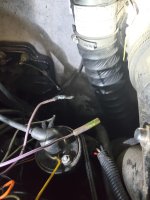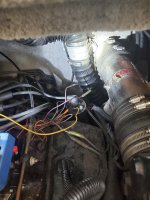So I took the ground wire off. It wasn't in bad shape at all. I cleaned the connectors. I removed the new starter and sanded were it butts up to the block since I thought it was a source of ground. The boat still just clicks when I try to start.
Not sure if it could be any of these purple wires. I can't figure out were they go.
Any helpful ideas?
Put some kind of corrosion protection on the bare metal where you sanded it.
Was it a hard click, or kind of soft, as if nothing is really moving? It should be a hard click if the solenoid is moving. Does it sound like the Bendix is moving into the flywheel gear teeth?
If your test light has an LED, it's useless for this test because it will illuminate at much lower voltage that you need to see. The only test light that could be useful has an incandescent bulb, because its brightness shows higher Current and voltage.
The next stuff is all procedural, but it should be done on any boat that's more than about ten years old but having written that, I would strongly recommend unplugging the boat harness and inspecting each side- it's supposed to have grease inside of the soft plastic sleeve, but the posts can corrode, anyway. I have seen boats do strange things and these included trim gauge/instruments/starter not working properly.
Are the battery cables just slipped onto the battery's terminals, or have they been cleaned and tightened? Wing nuts are no longer allowed by the Coast Guard and NyLock (Aviation) nuts shouldn't be used because the plastic can melt, making that useless- a lock washer should be used, instead.
With clean terminals and posts, connect a multi-meter's ground wire to the battery negative terminal and measure the voltage at the positive terminal. Then, measure voltage when touching the probe to the positive battery cable's terminal- if you see ANY difference, the post and clamp/ring terminal aren't really clean & tight. Next step is to measure voltage at the other end of the Positive cable- you should see the same voltage as what you measured at the positive post, within about .1VDC. If it's more, find out why- if the cables are old, try to flex the cable at each end and if it's stiffer than in the middle, it might be best to try it with a different cable- the stiffness usually indicates corrosion inside of the jacket. I have seen cables break when bent because of the loss of metal in that area.
If the Positive side tests good, repeat it by leaving one of the meter's wires on the Positive post and repeat all of the tests on the Negative cable- don't worry about seeing a
- sign ahead of the numbers.
If this tests as good, measure the voltage on the purple wires at the ignition switch and at the engine- you should see the same voltage at each end, within a few 10ths of a Volt. If it's significantly lower at the starter engine, and it should be the same at all the coil +, use a jumper from the battery + cable on the solenoid to connect to the crank post on the starter. If it cranks, you have found the problem- it would be on the purple wire.
Have you tried to rotate the crank manually? If it can't be turned (know when to stop cranking it, or the bolt will break- if you try to turn it in reverse, the bolt will come out), pull the spark plugs and see if the cylinders have water in them.
*NOTE- The need to smack a starter means the Bendix hasn't been lubed annually, which it should be. It sucks, but it will usually sit for months and that allows corrosion to work its magic. This is usually stated in the annual maintenance section of the boat/engine owner's manual.
The starter should crank when you connect 12V to one of the small posts- if it doesn't crank, try connecting to the other small post.
Hey, it happens.



